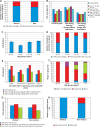Eye-tracked computer games as a method for pain perception alleviation in chronic wound management
- PMID: 37312920
- PMCID: PMC10258706
- DOI: 10.5114/ada.2022.119970
Eye-tracked computer games as a method for pain perception alleviation in chronic wound management
Abstract
Introduction: Chronic pain frequently accompanies the daily lives of many chronic wound patients. The degree of pain experienced significantly increases when performing medical procedures related to wound management. The use of eye-tracked games in order to distract the patient's attention from the painful activities performed can be an effective procedure.
Aim: Assesment of eye-trackers as a distractors during wound management.
Material and methods: Forty patients suffering from chronic wounds were qualified for the study. Patients performed eye tracking games during dressing changes and wound cleaning. Pain sensations were surveyed. The survey concerned the pain experienced on a daily basis, when changing the dressing without use and with the use of eye trackers.
Results: It was found that eye trackers significantly reduced the pain experienced during dressing changes compared to the pain caused by these procedures, but without the use of eye trackers.
Conclusions: On the basis of the obtained results, it was proposed to introduce eye trackers into routine clinical practice during chronic wound management.
Keywords: chronic wounds; dressing change; eye trackers; pain management.
Copyright: © 2022 Termedia Sp. z o. o.
Conflict of interest statement
The authors declare no conflict of interest.
Figures





Similar articles
-
Efficacy of lidocaine wet compress combined with red-light irradiation for chronic wounds.World J Clin Cases. 2023 Oct 26;11(30):7277-7283. doi: 10.12998/wjcc.v11.i30.7277. World J Clin Cases. 2023. PMID: 37969445 Free PMC article.
-
Dressing-related pain in patients with chronic wounds: an international patient perspective.Int Wound J. 2008 Jun;5(2):159-71. doi: 10.1111/j.1742-481X.2008.00471.x. Int Wound J. 2008. PMID: 18494622 Free PMC article.
-
The importance of pain reduction through dressing selection in routine wound management: the MAPP study.J Wound Care. 2004 Nov;13(10):409-13. doi: 10.12968/jowc.2004.13.10.27268. J Wound Care. 2004. PMID: 15575566
-
Managing painful chronic wounds: the Wound Pain Management Model.Int Wound J. 2007 Apr;4 Suppl 1(Suppl 1):4-15. doi: 10.1111/j.1742-481X.2007.00311.x. Int Wound J. 2007. PMID: 17394625 Free PMC article. Review.
-
The emergency care of traumatic wounds: current recommendations.Vet Clin North Am Small Anim Pract. 1994 Nov;24(6):1249-74. doi: 10.1016/s0195-5616(94)50137-2. Vet Clin North Am Small Anim Pract. 1994. PMID: 7879362 Review.
Cited by
-
Clinical observation of ultraviolet therapy combined with autologous platelet-rich plasma in the treatment of chronic refractory wounds.Int Wound J. 2024 Apr;21(4):e14746. doi: 10.1111/iwj.14746. Int Wound J. 2024. Retraction in: Int Wound J. 2024 Dec;21(12):e70165. doi: 10.1111/iwj.70165. PMID: 38654547 Free PMC article. Retracted.
References
-
- White RJ. Pain assessment and management in patients with chronic wounds. Nurs Stand 2008; 22: 62. - PubMed
-
- Paschou SA, Stamou M, Vuagnat H, et al. . Pain management of chronic wounds: diabetic ulcers and beyond. Maturitas 2018; 117: 17-21. - PubMed
-
- Jamshidi S, Parker JS, Hashemi S. The effects of environmental factors on the patient outcomes in hospital environments: a review of literature. Front Architectural Res 2020; 9: 249-63.
-
- Laursen J, Danielsen A, Rosenberg J. Effects of environmental design on patient outcome: a systematic review. HERD 2014; 7: 108-19. - PubMed
LinkOut - more resources
Full Text Sources
